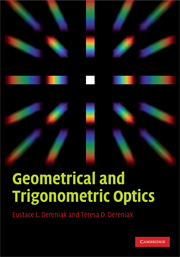Book contents
- Frontmatter
- Contents
- Preface
- 1 Light propagation
- 2 Reflections and refractions at optical surfaces
- 3 Image formation
- 4 Mirrors and prisms
- 5 Curved optical surfaces
- 6 Thin lenses
- 7 Thick lenses
- 8 Mirrors
- 9 Optical apertures
- 10 Paraxial ray tracing
- 11 Aberrations in optical systems
- 12 Real ray tracing
- Appendix A Linear prism dispersion design
- Appendix B Linear mixing model
- Appendix C Nature's optical phenomena
- Appendix D Nomenclature for equations
- Appendix E Fundamental physical constants and trigonometric identities
- Glossary
- Index
- References
10 - Paraxial ray tracing
Published online by Cambridge University Press: 06 July 2010
- Frontmatter
- Contents
- Preface
- 1 Light propagation
- 2 Reflections and refractions at optical surfaces
- 3 Image formation
- 4 Mirrors and prisms
- 5 Curved optical surfaces
- 6 Thin lenses
- 7 Thick lenses
- 8 Mirrors
- 9 Optical apertures
- 10 Paraxial ray tracing
- 11 Aberrations in optical systems
- 12 Real ray tracing
- Appendix A Linear prism dispersion design
- Appendix B Linear mixing model
- Appendix C Nature's optical phenomena
- Appendix D Nomenclature for equations
- Appendix E Fundamental physical constants and trigonometric identities
- Glossary
- Index
- References
Summary
Paraxial ray tracing is a technique used in geometrical optics for predicting the paths light will take through an optical system. Its primary application is in the design of lens and mirror systems.
Rays may be viewed as comprising streams of photons emanating from a light source and propagating toward surfaces throughout the optical system. As discussed in Chapter 2, four things may happen as rays strike optical surfaces: they may be refracted (transmitted), reflected, scattered, or absorbed. These effects may occur singly or in combination, and all of the energy in the incident beam must be accounted for by these mechanisms.
To review, refracted light enters a transparent medium at an angle different from the incident angle. Some of the energy in the incident beam will also be reflected by the surface. The surface may scatter some of the incident light in one or more directions. Additionally, it may absorb some of the energy, resulting in a loss of intensity in the beam. Refracted and reflected rays may strike other surfaces, at which the same mechanisms will again take effect, and at which Snell's law may be applied.
Paraxial ray tracing is applied to systems in which diffraction and interference effects are insignificant. It is useful for modeling and optimizing the design of lens systems and instruments, (e.g. minimizing the effects of aberrations) before optical components are ordered or fabricated. The technique finds utility in many applications, a particular example being illumination engineering.
- Type
- Chapter
- Information
- Geometrical and Trigonometric Optics , pp. 255 - 291Publisher: Cambridge University PressPrint publication year: 2008



